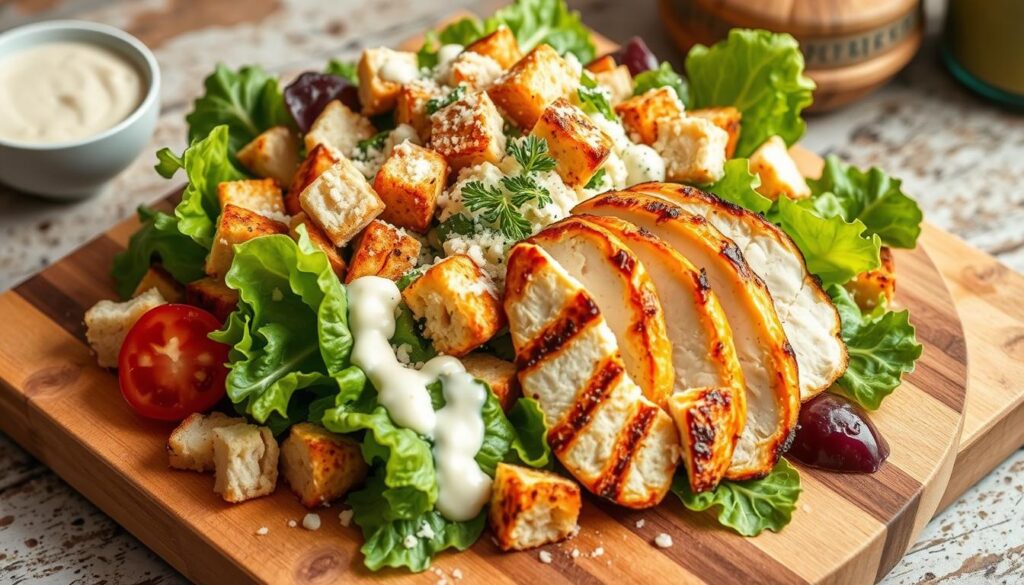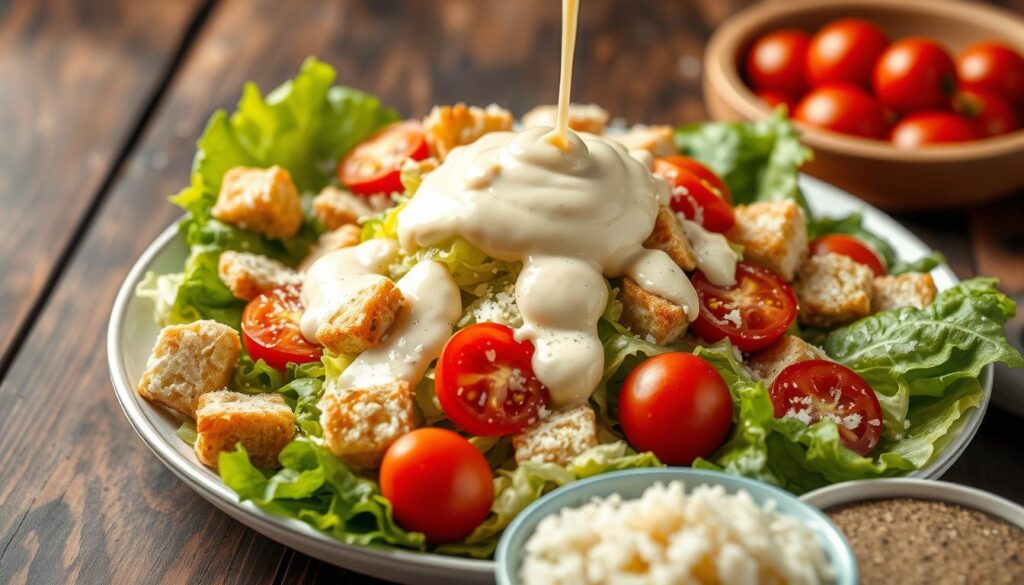Ever wonder about the hidden nutritional story behind your favorite Caesar salad? As a food enthusiast, I’ve spent years exploring culinary landscapes. I’ve found that chicken caesar salad nutrition information is more complex than most people think. The journey from simple ingredients to a balanced meal is truly fascinating.
Join me on this in-depth guide to the caesar salad nutritional value. We’ll see how each ingredient helps meet your dietary goals. Whether you’re health-conscious or just curious about the calories in a Caesar salad, this journey will change how you see this classic dish.
Chicken Caesar salad nutrition:Key Takeaways
- Caesar salad offers a balanced mix of protein, vegetables, and essential nutrients
- Homemade versions provide better nutritional control compared to restaurant options
- Ingredient choices significantly impact overall calorie and nutrient content
- Chicken provides high-quality protein with minimal added calories
- Portion size plays a critical role in maintaining nutritional balance
- Smart ingredient substitutions can enhance the salad’s health profile
Chicken Caesar Salad Nutrition: Understanding Components and Caloric Content

Exploring Caesar salad’s nutrition starts with knowing its main ingredients. The calories in a Caesar salad can change a lot. This depends on the ingredients and how much you eat.
Core Ingredients and Their Caloric Impact:Chicken Caesar Salad Nutrition
Every part of a Caesar salad adds something special to its nutrition. Let’s look at the main parts:
- Romaine lettuce: A nutrient-rich base with just 8 calories per cup
- Parmesan cheese: Adds about 100 calories per ounce
- Croutons: Contribute around 150 calories per serving
- Caesar dressing: The highest calorie part
Chicken Caesar salad nutrition:Portion Size Considerations
Your Caesar salad’s nutrition can change a lot with portion size. A small side salad might have 0.25 to 0.5 ounces of Parmesan cheese. This is about 25-50 calories.
Restaurant vs Homemade Calorie Comparison
Restaurant Caesar salads usually have more calories than homemade ones. A restaurant side salad can have 200-250 calories. But, making it at home can keep calories lower.
Being careful with ingredients and portions lets you enjoy Caesar salad. You can also keep your nutrition in check.
Chicken Caesar Salad Nutrition: The Role of Caesar Dressing in Nutritional Value

Caesar dressing is key to the nutritional value of a Caesar salad. A single tablespoon has about 78 calories. This makes it a big part of the salad’s calorie count. Knowing the fat content in Caesar dressing helps you make better food choices.
The nutritional value of Caesar dressing varies. Homemade versions use ingredients like olive oil, Parmesan cheese, anchovies, egg yolks, and mayonnaise. These add healthy fats, calcium, protein, and omega-3 fatty acids.
Store-bought Caesar dressings are convenient. Light or reduced-fat options can cut calorie content by up to 50%. For example, two tablespoons of traditional Caesar dressing have about 155 calories. A light version might have 75-80 calories.
Brands like Kraft, Newman’s Own, and Trader Joe’s offer different Caesar dressing options. When picking a dressing, keep these tips in mind:
- Check the serving size
- Compare calorie and fat content
- Look for dressings with natural ingredients
- Consider portion control
While Caesar dressing adds flavor, it can also affect your salad’s nutrition. Choose wisely to enjoy a tasty yet balanced meal.
Chicken Caesar Salad Nutrition: Protein Content and Best Sources
Starting a high-protein caesar salad means knowing the main protein sources. These make the dish not just tasty but also nutritious. Your chicken caesar salad is packed with protein, helping your muscles and keeping you full.
Protein is key to a nutritious caesar salad. Let’s look at the main protein sources:
Chicken Breast Nutritional Benefits
Chicken breast is the main protein in a traditional caesar salad. A serving gives you:
- About 19 grams of lean protein
- Low in saturated fat
- Rich in essential amino acids
- Only 220 calories per serving
Parmesan Cheese Protein Contribution
Parmesan cheese is also a protein powerhouse. Each ounce adds about 7 grams of protein and flavor to your salad.
Alternative Protein Options
Looking for something different? Try these protein alternatives:
- Grilled shrimp – lean and protein-rich
- Tofu – great for vegetarians
- Chickpeas – plant-based protein
- Hard-boiled eggs – extra protein
By mixing these protein sources, you can make your caesar salad a balanced meal. It supports your dietary needs.
Chicken Caesar Salad Nutrition Information: Complete Breakdown
Exploring chicken Caesar salad nutrition can guide your food choices. This salad is packed with nutrients, with calorie and macronutrient amounts varying. This depends on how it’s made and what’s in it.
Let’s look at the key nutrients in a chicken Caesar salad:
- Calorie Range: 300-500 calories per serving
- Fat Content: 40-52% of total calories
- Protein: 28-48g per serving
- Carbohydrates: 20-35g per serving
The main calorie sources in a Caesar salad are:
- Dressing: 150-200 calories
- Chicken: 130-150 calories
- Parmesan cheese: 25-50 calories
- Croutons: 50-150 calories
Your nutrition intake varies with portion size and ingredients. Making it at home lets you control calories better. A chicken Caesar salad has a good balance of protein, fats, and carbs.
Pro tip: Choose lighter dressings or use them sparingly to keep calorie count down. This way, you can enjoy the salad without overdoing it.
Chicken Caesar Salad Nutrition: Crouton Considerations and Their Impact
Croutons are key in a Caesar salad’s nutritional value. They add more than just crunch to your meal. Knowing their calorie impact helps you make better food choices.
The type of croutons you choose affects the salad’s calories. Homemade croutons are often a healthier option than store-bought ones. Here’s what you need to know:
- A typical serving of 10-15 croutons contains around 150 calories
- Each crouton averages about 10-12 calories
- Whole grain croutons provide additional fiber and nutrients
The calories come from bread and fats like olive oil or butter. If you’re watching your calories, try these tips:
- Opt for homemade whole grain croutons
- Control portion sizes
- Choose lighter preparation methods
Making smart choices with croutons lets you enjoy your salad while keeping your diet balanced. Paying attention to these small bread cubes helps manage your Caesar salad’s nutritional value.
Chicken Caesar Salad Nutrition: How to Make Your Salad Healthier
Creating a nutritious low-fat caesar salad doesn’t mean you have to give up flavor. By choosing the right ingredients, you can make a classic recipe healthier. This way, you can enjoy a salad that tastes great and meets your health goals.
Smart Ingredient Substitutions
Make your caesar salad healthier with a few simple swaps:
- Replace traditional mayonnaise-based dressing with Greek yogurt
- Use grilled chicken breast instead of fried chicken
- Choose whole grain croutons or reduce crouton quantity
- Add extra vegetables like cherry tomatoes and cucumbers
Portion Control Strategies
Controlling your portions is key for a balanced meal. A healthy chicken Caesar salad has less than 350 calories and over 30 grams of protein. Be sure to measure your ingredients to keep your meal balanced.
Balancing Nutrients
Make sure your low-fat caesar salad has a good mix of lean proteins, fresh veggies, and a bit of cheese. Your goal is to make a meal that’s filling but not too high in calories.
- Protein per serving: 33.8g
- Calories per serving: 312 kcal
- Fat per serving: 11.9g
Try these tips to make a tasty and healthy caesar salad that supports your health goals.
Chicken Caesar Salad Nutrition: Restaurant Chain Analysis
Exploring calories in caesar salad at different restaurants shows big differences. Knowing these can help you choose better.
Let’s look at the nutritional values of caesar salads at well-known places:
- Panera Bread:
- Half portion: 210 calories
- Full portion: 410 calories
- Applebee’s:
- Small Caesar salad: 230 calories
- Large Chicken Caesar salad: 790 calories
- Large Chicken Caesar with breadstick: 980 calories
- Longhorn Steakhouse:
- Side Caesar salad: 250 calories
- Chicken Caesar salad: 670 calories
- Salmon Caesar salad: 800 calories
Remember, these calorie counts can vary. This is due to different ingredients and sizes. Dressings and toppings also add calories.
Always check the latest nutrition info at the restaurant. This way, you can make the best choices for your diet.
Hidden Calories and Common Misconceptions
Exploring Caesar salad calories can be confusing. Many think it’s a healthy choice but overlook the hidden fats and calories. Knowing these secrets can help you choose better at the table.
Dressing Portion Pitfalls
Caesar salad dressing is a big calorie culprit. Just two tablespoons can have 110-120 calories and 12 grams of fat. But, most restaurants serve way more, making the salad much higher in calories.
- Standard dressing serving: 2 tablespoons
- Actual restaurant serving: Often 4-5 tablespoons
- Potential calorie increase: Up to 250-300 calories from dressing alone
Cheese Amount Assessment
Parmesan cheese might seem harmless, but it adds a lot of fat to your salad. A small amount can add 40-50 calories and several grams of fat. Chefs often add a lot of cheese, which can make the salad very high in calories.
Restaurant Serving Size Reality
Restaurant Caesar salads can be high in calories. What looks like a light meal can have 600-700 calories. The extra dressing, cheese, and protein make it much more calorie-dense than expected.
To keep your calorie intake in check, ask for dressing on the side. This way, you can control how much you eat. It helps you enjoy your meal more and stay mindful of what you’re consuming.
Incorporating Caesar Salad into a Balanced Diet
Making a healthy caesar salad recipe is all about smart nutrition. This classic dish can be a great part of your diet if you choose wisely. A low-fat caesar salad is a smart choice for your meals.
Here are some tips to make your caesar salad super healthy:
- Choose lean protein sources like grilled chicken breast
- Use romaine lettuce for high vitamin content
- Control portion sizes to manage calorie intake
- Prepare homemade dressing with lighter ingredients
When making your low-fat caesar salad, aim for nutrient-rich ingredients. Romaine lettuce is packed with vitamins A and K. Grilled chicken adds lean protein. Try to make a balanced plate that meets your nutritional needs.
Here are some nutritional tips for your healthy caesar salad recipe:
- Limit high-sodium ingredients if managing blood pressure
- Replace traditional croutons with nuts or seeds for added nutrition
- Use Greek yogurt as a lighter dressing alternative
- Incorporate additional vegetables for increased fiber
With the right preparation, a caesar salad can be a tasty and healthy meal. It can help you stay on track with your dietary goals.
Conclusion
Your journey through chicken caesar salad nutrition information shows a tasty and flexible dish. It’s great for a balanced diet. With only 6g of net carbs per serving, it’s a protein-packed meal. It mixes lean shredded rotisserie chicken with crisp romaine lettuce and tasty ingredients like Parmesan cheese and artichoke hearts.
Making a healthy caesar salad at home lets you choose the best ingredients and control how much you eat. By making smart swaps and watching the dressing, you can make this classic dish healthier. Homemade versions are more flexible than what you get at restaurants.
The secret to loving chicken caesar salad is in making smart choices. It’s perfect for a healthy lifestyle or just a tasty meal. Try new ingredients, use fresh parts, and enjoy a dish loved by many for years.

